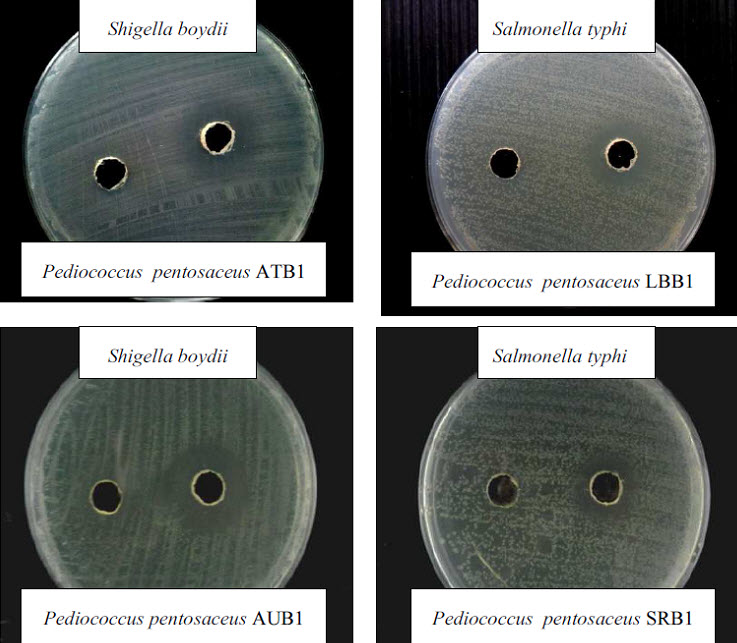ประสิทธิภาพการยับยั้งแบคทีเรียก่อโรคทางเดินอาหารโดยแบคทีเรียกรดแลกทิกจากลูกแป้งข้าวหมาก
Main Article Content
Abstract
Arun Chanchaichaovivat and Atthawit Utiansut
รับบทความ: 18 สิงหาคม 2556; ยอมรับตีพิมพ์: 3 ตุลาคม 2556
บทคัดย่อ
การวิจัยครั้งนี้มีวัตถุประสงค์เพื่อวิเคราะห์และเปรียบเทียบประสิทธิภาพของแบคทีเรียกรดแลกทิก Pediococcus pentosaceus AUB1 ATB1 SRB1 และ LBB1 ที่แยกได้จากลูกแป้งข้าวหมากในการยับยั้งเชื้อก่อโรคทางเดินอาหาร คือ Escherichia coli Staphylococcus aureus Salmonella typhi Shigella flexneri Shigella boydii และ Shigella sonnei ที่ภาวะค่าความเป็นกรด–เบส และอุณหภูมิแตกต่างกัน ทดสอบประสิทธิภาพโดยวิธี well test และตรวจสอบการอยู่รอดชีวิตของแบคทีเรียกรดแลกทิกที่ภาวะเลียนแบบระบบย่อยอาหารด้วยวิธี viable cell count ผลการทดลองพบว่า ค่าความเป็นกรด–เบสและอุณหภูมิมีผลต่อประสิทธิภาพการยับยั้งของ Pediococcus pentosaceus โดยที่อุณหภูมิ 30 องศาเซลเซียสและค่าความเป็นกรด–เบส 5.0 และ 7.0 ให้ผลการยั้บยั้งในภาพรวมดีที่สุด ซึ่งที่ภาวะนี้สายพันธุ์แบคทีเรียกรดแลกทิก AUB1 ATB1 SRB1 และ LBB1 สามารถยับยั้งแบคทีเรียก่อโรคทางเดินอาหารได้ 5 ชนิด ยกเว้น Staphylococcus aureus และเมื่อทดสอบความสามารถในการอยู่รอด-ชีวิตของ P. pentosaceus ทั้ง 4 สายพันธุ์ พบว่า ไม่สามารถทนต่อภาวะที่มีเอนไซม์เพปซินเข้มข้น 3.0 mg/mL ที่ภาวะความเป็นกรด–เบส 3.0 และ 2.5 และภาวะมีน้ำดีร้อยละ 1.0–7.0 ที่ค่าความเป็นกรด–เบส 8.0 มีผลทำลาย Pediococcus pentosaceus
คำสำคัญ: Pediococcus pentosaceus แบคทีเรียกรดแลกทิก แบคทีเรียก่อโรคทางเดินอาหาร เพปซิน น้ำดี
Abstract
This research aimed to analyze and compare inhibitory effects of lactic acid bacteria, Pediococcus pento-saceus AUB1, ATB1, SRB1 and LBB1, which was isolated from LoogPang Kaomark on enteropathogenic bacteria, Escherichia coli, Staphylococcus aureus, Salmonella typhi, Shigella flexeri, Shigella boydii and Shigella sonnei. Well test with viable cell count of lactic acid bacteria and survival detection in enteric simulation system were investigated. In overall, the results of bioassay showed that lactic acid bacteria, Pediococcus petosaceus AUB1, ATB1 and SRB1, which were cultivated at temperatures of 30 oC as well as pH 5.0 and 7.0, performed the highest inhibitory effects against 5 enteropathogenic bacteria, except Staphylococcus aureus. However, 4 strains of P. petosaceus can not survive in 3 mg/mL pepsin at pH 3.0 and 2.5. Moreover, bile solution at the concentration of 1–7% (pH 8.0) showed bactericidal agent for the four strains of P. petosaceus.
Keywords: Pediococcus pentosaceus, Lactic acid bacteria, Enteropathogenic bacteria, Pepsin, Bile
Downloads
Article Details

This work is licensed under a Creative Commons Attribution-NonCommercial 4.0 International License.
References
ไชยวัฒน์ ไชยสุต. (2554). โพรไบโอติก: จุลินทรีย์เพื่อชีวิต. จังหวัดเชียงใหม่: นวัตกรรมสุขภาพ.
นภา โล่ห์ทอง. (2537). กล้าเชื้ออาหารหมักและเทคโน-โลยีการผลิต. กรุงเทพมหานคร: ฟันนี่ พับบลิชชิ่ง.
วีระสิทธิ์ กัลยากฤต และวรศักดิ์ ช่างภา. (2553). อิทธิพลของสารสกัดหยาบสมุนไพรต่อจุลินทรีย์ในลูกแป้ง. การประชุมทางวิชาการของมหาวิทยาลัยเกษตร-ศาสตร์ ครั้งที่ 48, หน้า 211–217. กรุงเทพฯ: มหาวิทยาลัยเกษตรศาสตร์.
อรุณ ชาญชัยเชาว์วิวัฒน์ วันทนี สว่างอารมณ์ สุวินัย เกิดทับทิม และอนัตยา ผาสุข. (2555). วิทยาศาสตร์บูรณาการกับภูมิปัญญาท้องถิ่นเพื่อสุขภาพและชุมชนในการ ศึกษาด้านประสิทธิภาพของสารสกัดข้าวหมาก: อาหารโพรไบโอติกต่อการยับยั้งแบคทีเรียก่อโรคทางเดินอาหาร. กรุงเทพฯ: มหาวิทยาลัยราชภัฏบ้านสมเด็จเจ้าพระยา.
Cleveland, J., Montvile, T. J., Nes, I. F., and Chikindas, M. L. (2001). Bacteriocins: Safe, natural antimicrobials for food preservation. International Journal of Food Microbiology 71: 1–20.
Duangjitcharoen, Y., Kantachote, D., Ongsakul, M., Poosaran, N., and Chaiyasut, C. (2009). Potential use of probiotic Lactobacillus plantarum SS2 isolated from a fermented plant beverage: Safety assessment and persistence in the murine gastrointestinal tract. World Journal of Microbiology and Biotechnology 25: 315–321.
Grajek, W., Olejnik, A., and Sip, A. (2005). Probiotics prebiotics and antioxidants as functional foods. Acta Biochimca Polonica 52: 665–671.
Henderson, J. T., Chopko, A. L., and Wassenaar, P. D. (1992). Purification and primary structure of pediocin PA–1 produced by Pediococcus acidilactici PAC–1.0. Archives of Biochemis-try and Biophysics 295: 5–12.
Holck, A., Axelsson, L., Birkeland, S. E., Aukrust, T., and Blom, H. (1992). Purification and amino acid sequence of sakacin A, a bacteriocin from Lactobacillus sake LB706. Journal of General Microbiology 138: 2715–2720.
Holzapfel, W. H., and Schillinger, U. (2002). Introduction to pre and probiotics. Food Research Inter-national 35: 109–116.
Maeda, N., Nakamura, R., Hirose, Y., Murosaki, S., Yamamoto, Y., Kase, T., and Yoshikai, Y. (2009). Oral administration of heat-killed Lactobacillus plantarum L–137 enhances protection against influenza virus infection by stimulation of type I interferon production in mice. International Immunopharmacology 9: 1122–1125.
Murosaki, S., Yamamoto, Y., Ito, K., Inokuchi, T., Ku-saka, H., Ikeda, H., and Yoshikai, Y. (1998). Heat-killed Lactobacillus plantarum L–137 sup-presses naturally fed antigen-specific IgE production by stimulation of IL-12 production in mice. Journal of Allergy and Clinical Immunology 102: 57–64.
Rajsekhar, S., Kuldeep, B., Chandaker, A., and Upmanyu, N. (2012). Spices as antimicrobial agents: A review. International Research Journal of Pharmacology 3(2): 4–9.
Rittiplang, J., Laopaiboon, P., Vichitpan, K., and Dan-virutai, P. (2005). Lactic acid bacteria from indigeneous Loog-Pang samples of northeast-ern Thailand and their lactic acid production ability. The 1st International Conference on Fermentation Technology for Value Added Agricultural Products. Khon Kaen, Thailand.
Ryan, M. P., Hill, C., and Ross, R. P. (2002). In: Dutton, C. J., Haxell, M. A., McAuthor, H. A. and Wax, R. G. (Eds.), Peptides Antibiotics: Discovery, Modes of Action and Applica-tions. New York: Marcel Dekker.
Ryan, M.P., Rea, M.C., Hill, C., and Ross, R.P. (1996). An application in cheddar cheese manufac-ture for a strain of Lactococcus lactis producing a novel broad spectrum bacteriocin lacticin 3147. Applied and Environmental Microbio-logy 62: 612–619.
Sashihara, T., Sueki, N., and Ikegami, S. (2006). An analysis of the effectiveness of heat-killed lactic acid bacteria in alleviating allergic diseases. Journal of Dairy Science 89: 2846–2855.
Sirilun, S., Chaiyasut, C., Kantachote, D., and Luxa-nanil, P. (2010). Characterization of non human origin probiotic Lactobacillus plantarum with cho-lesterol-lowering property. African Journal of Microbiology Research 4: 994–1000.
